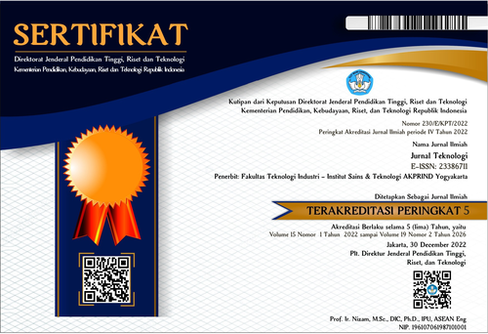KINETIKA REAKSI HIDROLISIS PATI PISANG TANDUK DENGAN KATALISATOR ASAM CHLORIDA
Keywords:
hidrolisis, pisang, patiAbstract
Tanaman pisang mudah tumbuh dan cepat berkembang biak di daerah tropis seperti di Indonesia, Buah pisang banyak mengandung pati yang terdiri atas karbohidrat yang dapat diolah menjadi glukosa dengan cara hidrolisis.
Proses hidrolisis pati pisang tanduk dengan katalisator HCl dilakukan dalam labu yang dilengkapi dengan pengaduk, pendingin balik thermometer serta dipanaskan di atas pemanas. Setiap 10 menit diambil sampel untuk dianalisis.
Penelitian dilakukan dengan variabel suhu dan konsentrasi katalisator HCl.Hasilpenelitian menunjukkan bahwa kinetika reaksi hidrolisis pati pisang tanduk menggunakan katalisator HCl merupakan reaksi order satu semu.
Dengan menggunakan perbandingan pati dan air 1 g:100 mL, konsentrasi HCl 2,5 N dan suhu 90oC diperoleh nilai konstanta kecepatan reaksi k= 0.007383 1/menit. Nilai konstanta kecepatan reaksi merupakan fungsi suhu yang dinyatakan dengan persamaan:
k = 1.0106 exp(-1844/RT), dalam menit -1 dengan temperatur reaksi (T) dalam Kelvin
Kata kunci: , pisang, pati
Downloads
References
Dlouhy,J.E., and Kott, 1948, Continous hidrolysis of Corn Starch, Chem Eng Progress, 44, p.899.
Groggins, P.H.,1958, Unit Processes in Organic Synthesis, 2 ed., pp 775-777, McGraw Hill Kogakusha, Ltd, Tokyo.
Kirk, R.E. and Othmer, D.F, 1951, Encyclopedia of Chemical Technology, vol. 5, pp. 781-790, Interscience Incyclopedia Inc., New York.
Levenspiel, O., 1972” Chemical Reaction Engineering, 2 ed.,p 299, Affilated East West Press DVT, Ltd, New Delhi
Redyowati dan Hascaryo, 1984, Hidrolisis Sorgum untuk memperoleh Gula Cair, Forum Teknik, 14 Hal. 1-10, Universitas Gadjah Mada, Yogyakarta.
Downloads
Published
How to Cite
Issue
Section
License
Jurnal Teknologi provides immediate open access to its content in order of making research freely available to the public to support a global exchange of knowledge. All articles published in this journal are free for everyone to read and download, under licence CC BY SA.
Benefits of open access for the author, include:
- Free access for all users worldwide.
- Authors retain copyright to their work.
- Increased visibility and readership.
- No spatial constraints.




















